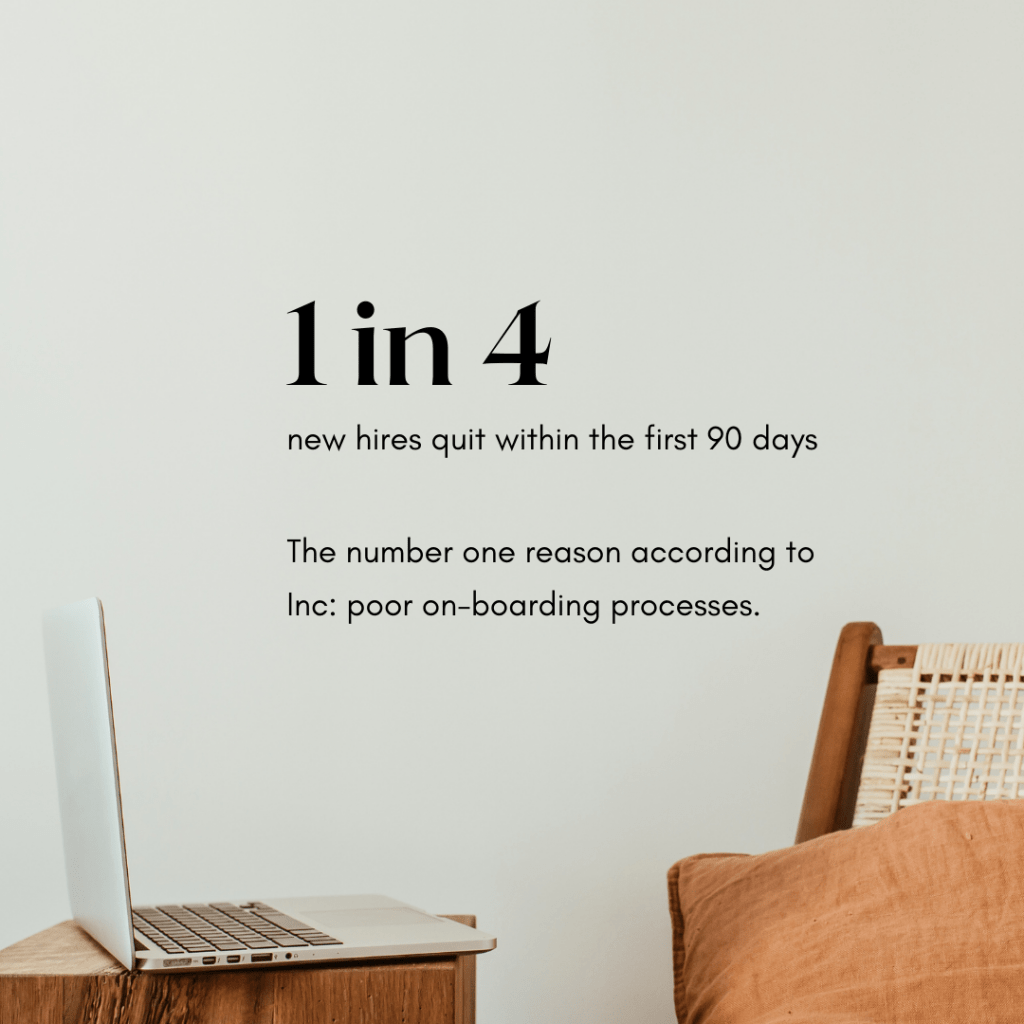
Uplift’s New Employee On-boarding Process Guide
This is our definitive guide to new employee on-boarding processes.
FACT: 1 in 4 new hires will quit within the first 90 days.
FACT 2: The cost of hiring a new employee was, on average, $16,500.

Think a formal on-boarding process is too costly or time-consuming to create and implement?
$16,500 is the cost of replacing an employee based on the median wage ($50k). Your business will spend at least this much each time you need to fill a role. Every time you lose a new employee in the first 90 days, you lose $16,500 minimum.
At Uplift, we believe you can easily reduce this cost by finding the right employees and making them feel welcome, informed, and excited about their job.
The following is our guide to setting up an onboarding process or updating your existing one.
Step 1: Informal vs. Formal Onboarding
I once worked in a business with no formal or stated onboarding process. On a new hire’s first day, they would arrive and be greeted by the receptionist who often had no idea the management had hired someone. The new employee would sit in the reception area for a good 20-30 minutes while random employees tried to figure out what was going on. Where was this new employee going to sit? Who would set up a computer for them and when? Which department? What is the person going to do today? About this time, a director might roll in from his coffee and greet the person before heading to his office leaving the new hire to sit in reception a bit longer…

I know this is what happened because it happened to me on my first day. Eventually, someone in the company started getting everyone together for lunch when a new employee started. But this wasn’t a company directive, just something that they started doing because they felt bad for the new guy who showed up to no formal onboarding process.
What if you boarded a plane and you had no idea where you were going, given no instructions, and no updates?
That’s what it feels like to be hired by a company with no formal onboarding process. This why you need this guide.
Thus, the very first thing you must do in creating an onboarding process is to decide whether to go with the scenario above or institute a formal procedure.
According to the Society for Human Resource Management (SHRM), “Organizations that engage in formal onboarding by implementing step-by-step programs for new employees to teach them what their roles are, what the norms of the company are, and how they are to behave are more effective than those that do not.”
If you can’t tell, we’d suggest going formal.

Step 2: Build Your Process Around the 4 “C’s”
Your company’s onboarding process should work from a new employee’s most basic needs to more complex issues.
Portland State University’s Talya N. Bauer refers to these needs as the Four C’s:
- Compliance: Includes essential company rules, policies, and legal procedures like dress code, time keeping procedures, and government policies.
- Clarification: Explain the new hire’s job requirements in detail. Let them know who they report to, the structure of their team, and the company as a whole.
- Culture: Highlight what makes your company culture unique from socialization to values.
- Connection: Help new employees feel at home at work by fostering a connection with your existing employees. You can do this through a buddy system, mentoring program, and/or team check-ins. This is absolutely vital to their success, you want your employees to have a reason to be excited and happy to come to work each day.
Step 3: Build Your Onboarding Process Into How You Recruit
“Managers need to remember that onboarding is not a one-time event,” says Mike Haberman of Omega HR Solutions. “It is a process that begins before the employee ever actually starts. Get them involved with the culture of the company early before they ever walk through the door.”
Recruiting is really the start of the onboarding process. If you can demonstrate your company is organized, people focused, and values long term relationships from the start, you’ll keep your happy employees for longer.
One key tip is to be as realistic as possible in describing a role and its responsibilities so that a candidate has a clear picture of what a normal day will look like once they start. This is powerful in two ways: first, it gives a candidate an opportunity to decline the job before they get hired and second, it makes a candidate more likely to stay because they know what they are getting into.

Step 4: Prepare Ahead of Time
“By failing to prepare, you are preparing to fail.”
In the story above, everyone had to scramble just to find the new hire a place to sit. Things like setting up his or her desk, getting FOBs and security clearances, the printing of the employee handbook and other documents for signatures need to be done ahead of time.
Take your preparation a step further and create a checklist for new hires that describes the basic functions of the role. That checklist should hit the Compliance and Clarification C’s so that the new employee can hit the ground running.
Some information to include on the Checklist:
- Team members and managers
- Software, logins, and the best methods of communication for the team
- Expectations and upcoming events or deadlines
- First assignment or smaller projects that can be started immediately.
One last thing, always send out an email to everyone in the office so they are prepared to welcome the new employee into the office on their first day.
Step 5: Day One Must Rock
We’ve said it before but first impressions are everything… You start leaving breadcrumbs during the recruiting process that lead a candidate to believe your company possesses a rock star culture and on boarding process. You continue by planning out and preparing for your new hire. Once everything is in place and ready to go, Day One is all about making the new employee feel confident that she will fit in, do her job well, and make an immediate impact on your business.
Most people expect a long-winded orientation day with lots of fluff and not a lot of real value. Don’t give that to them. On Day One, get right to your major projects and how your new hire will contribute to them in her role. Then, set realistic expectations by telling your new employee what is expected of her this week, month, quarter, and year.

Step 6: Make Week One About the New Hire
Don’t make the mistake of forcing your new employee to immediately adopt your company culture. Make the first week about the new person finding themselves, their role, and their identity within the company. It’s great that you love your company, but make sure the new guy understands your “why” so he can eventually get on board with the rest of you.
Just like the first day, the first week should be all about boosting the new hire’s confidence and showing him how he can use his skills and experience to benefit the company. The idea is that rather than just being a place to earn a living, the workplace is somewhere to develop into your best version of yourself.
Step 7: Back It Up with A Strong Company Culture
Once your new employee is feeling primed and confident about getting to work, introduce them to your company culture. Getting to know your company mission and values is an essential part of a successful onboarding process and the longevity and satisfaction of an employee in general.
After onboarding, an employee should know your “big picture” goals and values, be versed in the terminology and typical vernacular used, and understand how the general structure of your company.
Employees who are dedicated to a company’s mission are not only more productive and successful, they are generally happier and safer.
“When employees are dedicated to quality, they go the extra mile to do things right the first time. By taking the right strategic action – for example, by holding employees accountable for quality – leaders can develop a workforce that makes smart decisions throughout the day and promotes a culture of workplace safety.” States Brandon Rigoni and Bailey Nelson, authors of Gallup Business Journal’s “Engaged Workplaces Are Safer for Employees.”

Step 8: Foster Connection
Make it easy for new employees to build relationships within the company including with their peers and seniors. People are more likely to stick around when they have valuable connections and lasting relationships within a company.
One very effective method of creating relationships and specifically demonstrate how tasks are carried out is shadowing. New employees can read all the documentation on a specific role and then watch it carried out by someone experienced before they attempt it themselves.
A second method of fostering connection is via a mentorship program. A mentor can help make the new person’s first day less awkward, provide an easy support network and point of contact, help the new employee set themselves up for future success and promotion, and create a positive first impression of the organization.

Step 9: Follow-Up
Onboarding doesn’t end after the first week or even the first month. Expect to check in continuously at regular intervals to see if your new hire is comfortable, assimilated and thriving. Also, gather as much feedback as you can about the onboarding process itself so you can iterate and improve it down the track.
Follow this guide to make your recruiting investment last for years to come and create an incredible environment where smart people love to work and thrive!
